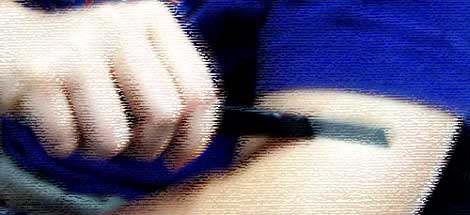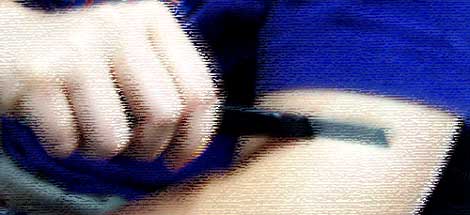Note: This article contains potentially distressing material. If you self-injure now or have in the past, please make yourself safe before reading these sections; they may temporarily intensify your urge to self-harm.

"I went downstairs and cut 5 times and one of them didn't stop bleeding for, like, half an hour. It was pathetic. I'm so worthless. This is not normal. I can't stop." Melody
"I have this terrible urge to cut my face and I don't know why ... My arms are a mess a complete and total mess... It saddens me to see what I can do to myself and not feel the pain..." Nora
"I've been cutting myself since August, with knives, scissors, razor blades, whatever I had. I wish I could explain in words the way I feel it, but I know that somehow I feel better when it's over."Lauren
Self-mutilation is far more widespread than is generally realized although it has gained media attention and books have been written on it in the US and UK. The New York Times, Newsweek, Time and even US teenage magazine, Seventeen have reported on it.
Last year, cable operator USA Network made Secret Cutting, an educational movie for teenagers, parents and educators. The movie was based on a book by Steven Levenkron, who treated the pop singer Karen Carpenter in her mortal battle with eating disorders.
However, in Asia, there has been hardly any media attention and no specific support groups are known to exist. Those who seek therapy usually turn to mental health clinics.
Newsweek magazine estimates that two million people in the US currently injure themselves through "cutting," and that most are women who started the practice as teenagers.
However, Dr Tracy Alderman who is a licensed clinical psychologist and author of The Scarred Soul told Fridæ that the number may be higher. "I would guess it's a bit higher, due to the secrecy involved, most people who self-injure don't let anyone else know about it. My best guess is closer to four million."
It was in the mid-nineties that the late Princess Diana shocked the world by confessing that she threw herself down the staircase and cut herself with razors, penknives and lemon slicers.
"You have so much pain inside yourself that you try to hurt yourself on the outside." The late princess told the BBC.
In an US Weekly interview, Shirley Manson, lead singer for the rock band Garbage said, "I wouldn't say that cutting was pleasurable, but there is a sense of euphoria that follows cutting yourself. The quick pinch of pain and the sight of blood snaps you back to the surface and you start to appreciate being alive."
Johnny Depp told People Magazine that his arms bear rows of scars from self-inflicted knife wounds, each one commemorating what he considers an important life event.
What is Self-mutilation?
Commonly dismissed as a symptom of other disorders notably borderline personality disorder, self-mutilation also known as self-injury, self-harm, self-cutting and self-abuse is the act of deliberately harming one's body and is often severe enough for tissue damage such as scarring.
The most common form of self-injury is cutting, usually minimally, but sometimes deeply. Some may also cut themselves, burn themselves or bang their bodies against something, scratch, and interfere with wound healing. People may also pull out their hair (trichitillomania) or rub glass onto their skin.
Major forms of self-injury (though rare) includes infrequent acts such as eye enucleation and castration, commonly associated with psychosis and intoxication.

It has been explained that cutters experience a kind of physiological shock response to highly emotional situations, and self-injury is the most immediate means of relief as such injuries may cause the release of endorphins, the body's naturally occurring opiates. Like any addictive behavior, most sufferers hurt themselves more often and more severely to achieve the same sense of relief. At the same time, a cycle of guilt, shame and self-hatred begins.
Self-mutilation and women
Although studies have not been conclusive, experts say that women are more likely than men to self-injure and are also more likely to suffer from other compulsive disorders, such as eating disorders or alcoholism.
According to Deb Martinson, who runs the Bodies Under Siege Web site, women are not socialized to express violence externally thus women tend to vent on themselves. "Men act out. Women act out by acting in."
"I'd also guess about 2/3 female in my experience, but there's some thought that men don't self-report and hide their self-harm more than women do." Martinson told Fridæ.
Self-injury, though more extreme, bears many similarities to other seemingly 'ordinary' form of self-harm such as drink or drugs. A woman may try to block out painful feelings by hurting herself; like taking risks or gambling, it may provide danger and distraction. Says the UK Bristol Crisis Service for Women (BCSW) that produces a series of booklets on self-injury.
"The majority of women who self-harm say the self-harming immediately follow feelings of emotional pain (sadness, grief, hopelessness and desperation), self-hatred (shame, guilt, dirtiness) or anger (frustration, powerlessness). Self-injury can be a way of achieving a sense of power and control over these feelings. Women who self-harm say that it is easier to cope with the physical pain than their emotional pain," reports the Threshold Women's Mental Health Initiative in UK.
Self-injury is also linked with (chronically) low self-esteem as young girls often grow up feeling responsible for the violence and abuse they receive. It may be a way of controlling and punishing one's body while at the same time being an act of defiance, an assertion of the right to do as we please with one's own body.
"Self-injurious behavior does not necessarily mean you were an abused child. It usually indicates that somewhere along the line, you didn't learn good ways of coping with overwhelming feelings," stated on Martinson's website on self-injury.
Experts agree that self-cutting most commonly begins during puberty. "Self-injury typically begins in adolescence and ends in one's 30's. However, some people do self-injure prior to adolescence and some keep on injuring throughout their lives," says Dr Alderman.
"� a chaotic, confusing time when emotions run high and self-esteem runs low," says Karen Conterio, administrative director of SAFE Alternatives in Berwyn, Illinois, the only inpatient treatment center exclusively for self-injurers in the United States.
While little research has been done to track the number of gays and lesbians who self-injure, gays and lesbians, especially those in their teens may feel anxiety, isolation and rejection, more so than others.
"I have noticed that there tend to be a higher proportion of bisexual and homosexual people who self-harm than there is in the general population." Said Martinson who runs self-help groups and has spoken with a few thousand people who self-harm over the last five years.
"I would tend to think that gays/lesbians may self-injure slightly more than others due to increased pressure, internalized homophobia, feelings of isolation/alienation, and feeling different from others," Dr Alderman told Fridæ.
The link between self-mutilation and suicide
Contrary to popular belief, experts now believe self-mutilation is not a botched up suicide attempt and self-injury may be a coping mechanism so that the cutter may continue living. However, it has been said that people who self-injure are statistically at a greater risk of going on to commit suicide.
While self-injurious behavior is not suicidal in intent, it can easily lead to death when a self-harmer goes too far.
Prof Favazza states "self-mutilation is distinct from suicide. Major reviews have upheld this distinction... A basic understanding is that a person who truly attempts suicide seeks to end all feelings whereas a person who self-mutilates seeks to feel better."
Getting help
Self-injurers often become desperate about their lack of self-control and the addictive-like nature of their acts, which may lead them to true suicide attempts. The self-injury behaviors may also cause more harm than intended, which could result in medical complications or death. Eating disorders and alcohol or substance abuse intensify the threats to the individual's overall health and quality of life.
Even the best therapies, however, are useless if patients have no desire to stop. For some, cutting is the only coping mechanism they know that works, and they are loathe to give it up.
Self-mutilators are often advised to provide some sort of distracting pain (such as snapping themselves with a rubber band worn around the wrist) or substitute action (one of the most interesting of these involves "slashing" oneself with a red magic marker). Psychotherapy and medication are usually used; medications employed range from Depakote and similar mood stabilizers to antidepressants to anti-anxiety drugs like Xanax and Klonopin.
Hartgrove Hospital in Chicago has an inpatient program specifically for self-mutilators. The program relies on 30 days of intensive individual and group therapy and 15 journaling exercises to help patients gain an awareness of why they hurt themselves and how to stop.
But the most effective therapies rely on plain old words. SAFE's Karen Conterio and Dr. Wendy Lader emphasize personal responsibility in their intensive, 30-day treatment program. Patients attend half a dozen group therapy sessions each day, in addition to one-on-one therapy sessions, and are required to write in journals.
Books:
Bodies Under Siege
by Armando Favazza
A Bright, Red Scream
by Marilee Strong
Bodily Harm - The Breakthrough Healing Program For Self-Injurers
by Karen Conterio and Wendy Lader
Women Who Hurt Themselves
by Dusty Miller
The Scarred Soul: Understanding & ending Self-Inflicted Violence
by Tracy Alderman
Cutting: Understanding and Overcoming Self-Mutilation
by Steven Levenkron
The Luckiest Girl in the World
by Steven Levenkron
Editor's Note: If you have any experiences to share or would like to set up a support group in Asia, email the Editor.











 打印版本
打印版本










读者回应
抢先发表第一个回应吧!
请先登入再使用此功能。